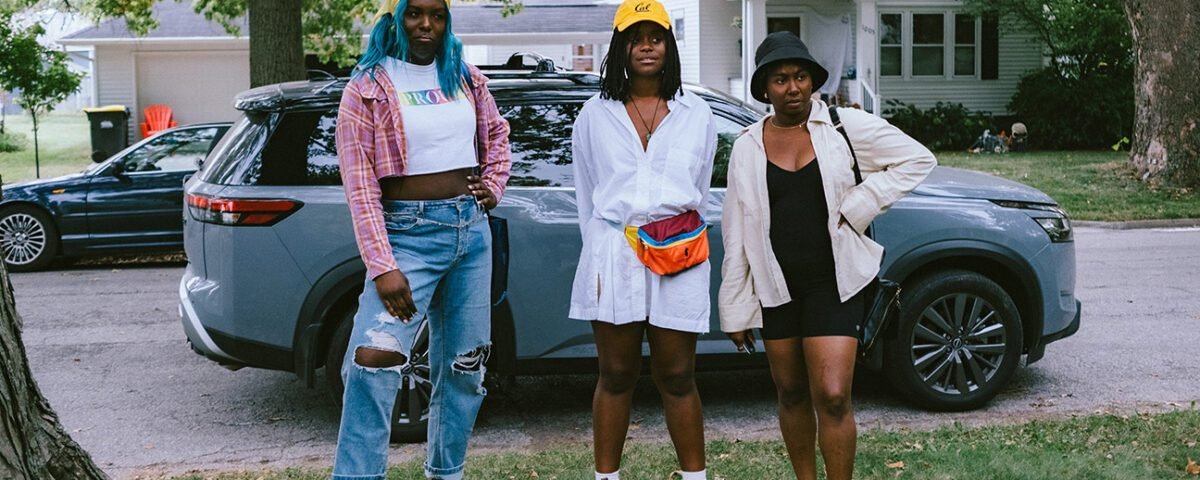


‘Trap’ Review: A Wily Josh Hartnett Propels M. Night Shyamalan’s Moderately Entertaining Thriller
August 3, 2024


‘It Ends With Us’ Review: Blake Lively Stars in Serviceable Adaptation of Colleen Hoover Novel
August 8, 2024The ‘Test Pattern’ director’s latest, which premiered at BlackStar Film Festival, follows a group of queer Black femmes journeying across America’s heartland in search of their friend.
Dreams in Nightmares
A soothing experiment in building atmosphere.
The title of Shatara Michelle Ford’s new film, Dreams in Nightmares, is a declarative statement, gesturing at once toward the world the director builds in their sophomore project and an understanding of Black queer existence in the United States. In spite of persistent national violence, Black queer people have always created loving, thriving communities. These pockets of joy — whether between friends, chosen family or neighbors — are soothing reveries interrupting often cruel realities. In Dreams in Nightmares, Ford borrows from and remixes the road movie to construct a vision of Black femmes finding peace.
The crew decides to drive from Brooklyn, where they’ve convened for an unexpected party weekend, to Iowa City, where Kel lives with their girlfriend Sabrina (Jasmin Savoy Brown). What starts as a rescue mission soon turns into a cathartic confrontation with deeply personal questions about employment, artistic frustrations and ideas about past, present and future selves.
Ford continues to consider the elasticity of storytelling in Dreams in Nightmares. Partnering with DP Ludovica Isidori, composer Lia Ouyang Rusli (Test Pattern, Problemista), costume designer Michaela Zabalerio and production designer Eloise Ayala, the director conjures a distinctive world for their endearing characters. The mood is defined by warm undertones and a hushed score, and Rusli’s pacific compositions live quite nicely with the energetic needle drops (music supervision by Alison Moses and Kayla Monetta).
Ford primarily experiments within the road movie tradition. (The director has cited Wim Wenders’ Paris, Texas as an inspiration.) They render a journey through the American heartland not as an idyllic jaunt in nature but a kind of terrorizing confrontation with reality.
For the first half of their trip, Lauren carefully maps out Black-owned businesses the crew can pause at for food or fuel. Later, when they come across at an eerily quiet pit stop, she comments on how the gas station is not part of her “green book,” referencing the traveler’s guide created to help African Americans in the the 20th century avoid racist locales. Conversations between characters about the Great Migration serve as reminders that the history of Black travel within the U.S. often began with escapes from violence and promises of economic freedom.
But what to do once we commit to Ford and the crew? That’s where Dreams in Nightmares can be more of a puzzle. Ford, who wrote the screenplay in addition to directing, crafts a narrative whose stakes wobble as the group gets closer to locating their friend. Some storylines wither and others are abandoned as they zoom from New York to Pennsylvania and then Iowa to Kansas. A particularly nagging loose thread revolves around Tasha’s character, who at the beginning of the film loses her job and struggles to navigate, it seems, not just the realities of abandoning acting for consulting but also her gender presentation. Z’s story offers a genuine portrayal of a polyamorous relationship and artistic frustration. But even there, too, I was left craving more details about the life she leads and the one she imagines for herself.
There’s an inherent illogic to dreams that maps them nicely onto the structure of a road movie. Ford’s characters float from one locale to another, finding themselves in scenarios that highlight different elements of life in America. Underground queer poetry slams in Pittsburgh, the grating self-absorption of graduate students in Iowa City and the inhibiting conservatism of Kansas City reveal aspects of Z, Tasha and Lauren’s dynamic personalities as well as hopes and fears. Still, considering the amount of time spent with them — Dreams in Nightmares runs a little over two hours — these characters can feel frustratingly opaque, as if they, like dreams, might fade too quickly.





